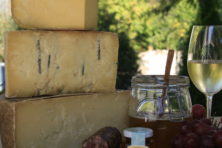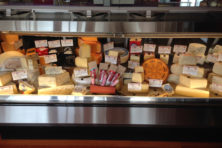The Cheese Insider
- Share
- Tweet
- Pin
- Share
I recently had a reader ask me to explain the differences between natural and processed cheese. Most Americans have eaten some type of processed cheese, including the cheese on nachos or Kraft Singles. Many of us were raised eating sandwiches that had some type of processed cheese in them, especially anyone over the age of 30.
When the word “natural” is used to describe some type of cheese it is to distinguish it from “processed” cheese. Natural cheese means a cheese that is made from milk and a few other key ingredients, namely culture (fermentation), enzymes (coagulants), salt, and in some cases annatto (color) is added. Milk is the starting ingredient, then a lactic acid bacterial fermentation to produce lactic acid. The rennet is added to coagulate the milk, and sometime annatto (a natural seed) is added for color. Salt is added last, either by a dry rub, or a brine tank, to add flavor and help in the preservation of the cheese. Making a natural cheese is a biological process, a bacterial fermentation of milk.
On the other hand, a “processed” cheese typically uses, not milk, but a variety or multiple varieties of “natural” cheese as its starting ingredient. Typically making a process cheese starts with a natural cheese as the raw ingredient, and uses emulsifying salts and heat to produce the end product. Emulsifying salts are defined as: “Substances which convert proteins contained in cheese into a dispersed form and thereby bring about homogenous distribution of fat and other components.” The concept of processed cheese began in 1910. One of the original people to perfect a process for making this type of cheese was J.L. Kraft, yes, the same Kraft which produces the singles that are sold today. The driving force behind creating this processed cheese was to eliminate waste that was created by the “trimming of the rind” of natural cheese. Also, one of the problems for satisfying consumers was that the same cheese being sold, but made in different plants, did not taste the same. They wanted to produce a cheese that tasted the same no matter where it was made. That same theory is what the fast food business across the world is all about: the cheeseburger from a McDonalds sold in Chicago should taste the same as the one sold in Hong Kong.
In the typical process of making a “processed” cheese, a natural cheese, most commonly cheddar is ground up, then water and emulsifying salts are added. The entire mixture is then heated and stirred to form a molten mass, then extruded into a form and cooled. The making of processed cheese is not a biological process, but rather uses chemistry (emulsifying salts) and physics (heat). The key ingredient in making processed cheese is the emulsifying salts. The emulsifying salt, typically a citrate or phosphate salt stabilizes the fat globules so that the cheese does not oil off when it is heated. Another example of this process is mayonnaise. Natural emulsifiers in the eggs in mayonnaise prevent the oils in the mayonnaise from separating. If you try and melt natural cheddar cheese in a pot the cheese will oil off and separate, and the protein in the cheese will form globs. The predecessor to “processed” cheese was Swiss Fondue. You shred some cheese, put it in a pot to heat, stir, and add some white wine, which makes the cheese liquid. The wine contains tartaric acid, a natural emulsifier, which stabilizes the fat globules so they don’t oil off and separate.
The FDA has standards for a number of grades of “processed” cheese. Pasteurized processed cheese is the highest grade; it contains mostly natural cheese along with a little emulsifying salts and water. This often comes in blocks and sometimes in slices. The next grade down is pasteurized process cheese food, which in addition to emulsifying salts allows for the addition of significantly more water, as well as other ingredients such as whey solids and buttermilk solids. This is the category that a lot of the sliced “singles” fit into. Last comes the pasteurized process cheese spread, and this product has even more lenient allowances for additional ingredients, and by law only has to contain 51 percent natural cheese. This is the product you most often see in a jar, sold as cheese for nachos or spread.
I hope this helps you understand a little more about the differences in “natural” and “processed” cheese.
Source: Dean Sommer, Center for Dairy Research, UW-Madison
Michael C. Thomas is co-owner of Schoolhouse Artisan Cheese with his wife Janice. With locations in Ellison Bay and Egg Harbor, they aim to bring the best of Wisconsin artisan cheeses to Door County, and with “The Cheese Insider” Michael hopes to bring all things cheese to readers of the Pulse. If you have a question for “The Cheese Insider” please email it to [email protected].




